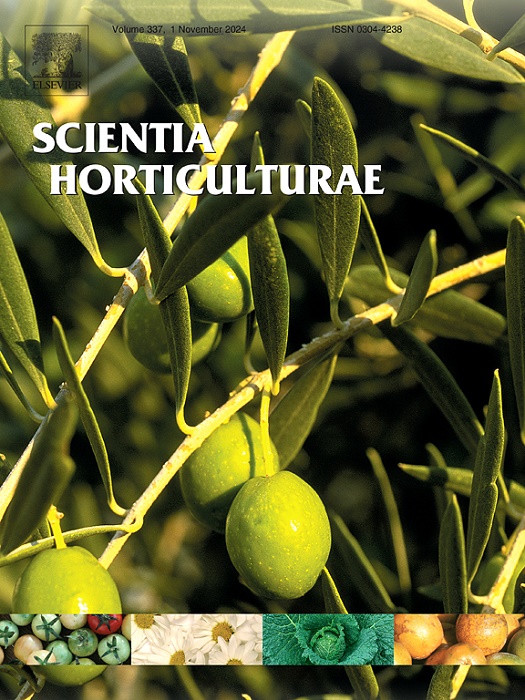亚热带周期性缺水地区澳洲坚果树蒸腾简单模型的建立与评价
IF 3.9
2区 农林科学
Q1 HORTICULTURE
引用次数: 0
摘要
在气候变化加剧的周期性严重缺水情况下,南非等亚热带地区日益增长的夏威夷果种植业的可持续水资源管理和灌溉效率的提高至关重要。这需要对不同条件下的树木需水量进行精确建模。然而,目前的方法往往缺乏准确性或需要大量的数据输入。在本研究中,我们采用并评估了一个简单、机械、低数据输入的澳洲坚果树蒸腾模型。为此,我们在南非半湿润的Levubu地区进行了一项全面的实验研究,收集了两个夏威夷果品种的树液速度数据,以及两个季节的小气候和土壤水分数据。首先,利用树木拦截辐射、蒸汽压亏缺(VPD)和冠层电导数据,在非限制水分条件下对模型进行校准,模拟代表夏威夷果水分利用上限的潜在树木蒸腾(Td)。其次,基于观测到的土壤水分蒸腾率(FTSW),对模拟电位Td进行了重新标度,进一步建立了水分亏缺条件下的Td模拟模型。根据两个品种独立数据集的观测结果验证了校准模型的性能。本文章由计算机程序翻译,如有差异,请以英文原文为准。
Adopting and evaluating a simple model for macadamia tree transpiration in periodically water-scarce subtropical regions
Sustainable water management and enhanced irrigation efficiency in the growing macadamia sector in subtropical regions such as South Africa are essential amid severe periodic water scarcity exacerbated by climate change. This requires precise modelling of tree water demand under varying conditions. However, current methods often lack accuracy or require extensive data inputs. In this study, we adopted and evaluated a simple, mechanistic, low data-input transpiration model for macadamia trees. To this end, we conducted a comprehensive experimental study in the sub-humid Levubu region, South Africa, collecting tree sap velocity data from two macadamia cultivars, along with microclimate and soil water data over two seasons. First, the model was calibrated under non-limiting water conditions using data on tree-intercepted radiation, vapor pressure deficit (VPD), and canopy conductance to simulate potential tree transpiration (Td), representing the upper limit of macadamia water use. Secondly, we further developed the model to simulate Td for water deficit conditions by rescaling simulated potential Td based on the observed fraction of transpirable soil water (FTSW). The performance of the calibrated model was validated against observed Td from (spared) independent datasets for both cultivars.
Observed macadamia Td showed pronounced seasonal variability (ranging from 0.6 mm d−1 in winter to 1.3 mm d−1 in summer), largely influenced by varying VPD and FTSW. The model captured the strong response of stomatal closure to increasing VPD, reflecting the conservative water use of macadamia trees. Model performance was satisfactory for both cultivars, and under both non-limiting and water deficit conditions, with lower relative error measures in the latter. This indicates that the improved model under water deficit is well-suited for accurately estimating macadamia Td under heterogeneous environmental conditions, making it a valuable tool for optimizing irrigation practices and conserving water resources in macadamia orchards.
求助全文
通过发布文献求助,成功后即可免费获取论文全文。
去求助
来源期刊

Scientia Horticulturae
农林科学-园艺
CiteScore
8.60
自引率
4.70%
发文量
796
审稿时长
47 days
期刊介绍:
Scientia Horticulturae is an international journal publishing research related to horticultural crops. Articles in the journal deal with open or protected production of vegetables, fruits, edible fungi and ornamentals under temperate, subtropical and tropical conditions. Papers in related areas (biochemistry, micropropagation, soil science, plant breeding, plant physiology, phytopathology, etc.) are considered, if they contain information of direct significance to horticulture. Papers on the technical aspects of horticulture (engineering, crop processing, storage, transport etc.) are accepted for publication only if they relate directly to the living product. In the case of plantation crops, those yielding a product that may be used fresh (e.g. tropical vegetables, citrus, bananas, and other fruits) will be considered, while those papers describing the processing of the product (e.g. rubber, tobacco, and quinine) will not. The scope of the journal includes all horticultural crops but does not include speciality crops such as, medicinal crops or forestry crops, such as bamboo. Basic molecular studies without any direct application in horticulture will not be considered for this journal.
 求助内容:
求助内容: 应助结果提醒方式:
应助结果提醒方式:


